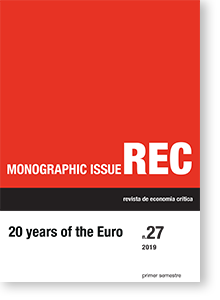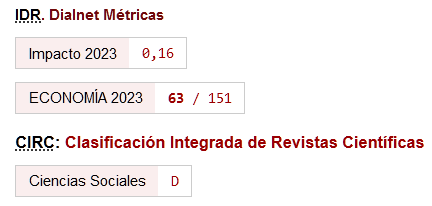Rethinking the euro as a common currency for Europe: Keynes’s Plan revisited
Keywords:
Euro area, financial crisis, Keyne's Plan, TARGET2 systemAbstract
This paper sets off from the monetary–structural origins of the euro-area crisis, which is not a sovereign debt crisis, but a crisis due to a lack of payment finality at international level. The first section explains that international payments across the euro area are not, to date, final for the countries concerned, as the European Central Bank does not operate as settlement institution for the national central banks involved thereby. The exploding TARGET2 imbalances observed in the aftermath of the euro-area crisis are an empirical evidence of this monetary–structural flaw. The second section suggests therefore that at the euro-area level there should be an international monetary institution issuing the euro as a common (instead of a single) currency for the euro-area member countries. Thereby those countries that are currently much in trouble within the euro area may reintroduce a national currency that allows them to recover monetary-policy sovereignty as a tool that can be used, together with fiscal policy, to steer the domestic economy in the country’s own interest. The third section concludes with some policy-oriented remarks, putting to the fore the major merits of transforming the euro from a single into a common currency in order to contribute to European (monetary) integration for the common good.
Downloads
References
Auer, Raphael (2014): "What drives TARGET2 balances? Evidence from a panel analysis", Economic Policy, vol. 29, no. 77, pp. 139-197.
https://doi.org/10.1111/1468-0327.12024
Barredo-Zuriarrain, Juan, Molero-Simarro, Ricardo and Quesada-Solana, Alejandro (2017): "Eurodependence - A peripheral look beyond the monetary union: a proposal of reform of the TARGET2", Review of Radical Political Economics, vol. 49, no. 3, pp. 375-393.
https://doi.org/10.1177/0486613417703958
Bibow, Jörg (2016): "Making the euro viable: the Euro Treasury Plan", European Journal of Economics and Economic Policies: Intervention, vol. 13, no. 1, pp. 72-86.
https://doi.org/10.4337/ejeep.2016.01.07
Board of Governors of the Federal Reserve System (2018a): Federal Reserve Act, Washington, Federal Reserve System, available online at www.federalreserve.gov/aboutthefed/fract.htm (last accessed on 24 December 2018).
Board of Governors of the Federal Reserve System (2018b): Financial Accounting Manual for Federal Reserve Banks, Washington: Federal Reserve System, available online at www.federalreserve.gov/monetarypolicy/ files/BSTfinaccountingmanual.pdf (last accessed on 24 December 2018).
Cecchetti, Stephen, McCauley, Robert and McGuire, Patrick (2012): "Interpreting TARGET2 balances", Bank for International Settlements Working Paper, no. 393.
Cecioni, Martina and Ferrero, Giuseppe (2012): "Determinants of TARGET2 imbalances", Bank of Italy Occasional Paper, no. 136.
https://doi.org/10.2139/ssrn.2176227
Cesaratto, Sergio (2015): "Balance of payments or monetary sovereignty? In search of the EMU 's original sin", International Journal of Political Economy, vol. 44, no. 2, pp. 142-156.
https://doi.org/10.1080/08911916.2015.1060830
Cesaratto, Sergio and Stirati, Antonella (2010): "Germany and the European and global crisis", International Journal of Political Economy, vol. 39, no. 4, pp. 56-86.
https://doi.org/10.2753/IJP0891-1916390403
De Grauwe, Paul (2013): "The European Central Bank as lender of last resort in the government bond markets", CESifo Economic Studies, vol. 59, no. 3, pp. 520-535.
https://doi.org/10.1093/cesifo/ift012
Draghi, Mario (2014): "Stability and prosperity in monetary union", Speech at the University of Helsinki, Helsinki, 27 November, available online at https://www.ecb.europa.eu/press/key/date/2014/html/ sp141127_1.en.html (last accessed on 24 December 2018).
European Central Bank (2007): Payment and Securities Settlement Systems in the European Union, Volume 1: Euro Area Countries, Frankfurt: European Central Bank.
European Central Bank (2011): TARGET Annual Report 2010, Frankfurt: European Central Bank.
Febrero, Eladio, Uxo, Jorge and Bermejo, Fernando (2018): "The financial crisis in the eurozone: a balance-of-payments crisis with a single currency?", Review of Keynesian Economics, vol. 6, no. 2, pp. 221-239.
https://doi.org/10.4337/roke.2018.02.04
Goodhart, Charles Albert Eric (1989): *Money, Information and Uncertainty*, London and Basingstoke: Macmillan, second edition (first published 1975).
https://doi.org/10.1007/978-1-349-20175-4
Kenen, Peter Bain (1969): "The theory of optimum currency areas: an eclectic view", in Robert Alexander Mundell and Alexander Swoboda (eds), *Monetary Problems of the International Economy*, Chicago: University of Chicago Press, pp. 41-60.
Keynes, John Maynard (1980): *The Collected Writings of John Maynard Keynes, vol. XXV, Activities 1940-1944. Shaping the Post-War World: the Clearing Union*, ed. by Donald E. Moggridge, London and New York: Macmillan and Cambridge University Press.
Lavoie, Marc (2015): "The Eurozone: similarities to and differences from Keynes's Plan", *International Journal of Political Economy*, vol. 44, no. 1, pp. 3-17.
https://doi.org/10.1080/08911916.2015.1035980
Machlup, Fritz (1963): "Reform of the international monetary system", in Herbert G. Grubel (ed.), *World Monetary Reform: Plans and Issues*, Stanford and London: Stanford University Press and Oxford University Press, pp. 253-60.
Mastromatteo, Giuseppe and Rossi, Sergio (2015): "The economics of deflation in the euro area: a critique of fiscal austerity", *Review of Keynesian Economics*, vol. 3, no. 3, pp. 336-350.
https://doi.org/10.4337/roke.2015.03.04
Mastromatteo, Giuseppe and Rossi, Sergio (2019): "The mirage of expansionary fiscal consolidation to resolve the euro-area crisis", in Kate Power, Tanweer Ali and Eva Lebduskova (eds), *Discourse Analysis and Austerity: Critical Studies from Economics and Linguistics*, London and New York: Routledge, forthcoming, pp. 253-265.
https://doi.org/10.4324/9781315208190-18
Mundell, Robert Alexander (1961): "A theory of optimum currency areas", *American Economic Review*, vol. 51, no. 4, pp. 657-665.
Padoa-Schioppa, Tommaso (2004): *The Euro and Its Central Bank: Getting United after the Union*, Cambridge, MA: MIT Press.
https://doi.org/10.7551/mitpress/2846.001.0001
Rossi, Sergio (2007a): *Money and Payments in Theory and Practice*, London and New York: Routledge.
https://doi.org/10.4324/9780203964071
Rossi, Sergio (2007b): "The monetary-policy relevance of an international settlement institution: the Keynes plan 60 years later", in Alberto Giacomin and Maria Cristina Marcuzzo (eds), *Money and Markets: A Doctrinal Approach*, London and New York: Routledge, pp. 96-114.
Rossi, Sergio (2009a): "Wechselkursschwankungen als Folge einer Währungsunordnung: Neugestaltung des internationalen Währungssystems im Sinne von Keynes", in Jürgen Kromphardt and Heinz-Peter Spahn (eds), *Die aktuelle Währungsunordnung: Analysen und Reformvorschläge*, Marburg: Metropolis Verlag, pp. 175-208.
Rossi, Sergio (2009b): "International payment finality requires a supranational central-bank money: reforming the international monetary architecture in the spirit of Keynes", *China-USA Business Review*, vol. 8, no. 11, pp. 1-20.
Rossi, Sergio (2009c): "A common currency for Middle Eastern and North African countries? Lessons from the European Monetary Union", in David Cobham and Ghassan Dibeh (eds), *Monetary Policy and Central Banking in the Middle East and North Africa*, London and New York: Routledge, pp. 226-245.
Rossi, Sergio (2012): "The monetary-structural origin of TARGET2 imbalances across Euroland", in Claude Gnos and Sergio Rossi (eds), *Modern Monetary Macroeconomics: A New Paradigm for Economic Policy*, Cheltenham and Northampton: Edward Elgar, pp. 221-238.
https://doi.org/10.4337/9781782540434.00018
Rossi, Sergio (2013): "Financialization and monetary union in Europe: the monetary-structural causes of the euro-area crisis", Cambridge Journal of Regions, Economy and Society, vol. 6, no. 3, pp. 381-400.
https://doi.org/10.1093/cjres/rst015
Rossi, Sergio (2015): "The euro-area crisis: structural origins and possible exit strategies", in Aristidis Bitzenis, Nikolaos Karagiannis and John Marangos (eds), Europe in Crisis: Problems, Challenges, and Alternative Perspectives, Basingstoke and New York: Palgrave Macmillan, pp. 143-154.
https://doi.org/10.1057/9781137438928_8
Rossi, Sergio (2017): "A structural-reform proposal for a two-speed European monetary union", in Nazaré da Costa Cabral, José Renato Gonçalves and Nuno Cunha Rodrigues (eds), The Euro and the Crisis: Perspectives for the Eurozone as a Monetary and Budgetary Union, London and New York: Springer, pp. 33-46.
https://doi.org/10.1007/978-3-319-45710-9_4
Rossi, Sergio and Dafflon, Bernard (2012): "Repairing the original sin of the European Monetary Union", International Journal of Monetary Economics and Finance, vol. 5, no. 2, pp. 102-123.
https://doi.org/10.1504/IJMEF.2012.048731
Schmitt, Bernard (1973): New Proposals for World Monetary Reform, Albeuve: Castella.
Simonazzi, Annamaria, Ginzburg, Andrea and Nocella, Gianluigi (2013): "Economic relations between Germany and southern Europe", Cambridge Journal of Economics, vol. 37, no. 3, pp. 653-675.
https://doi.org/10.1093/cje/bet010
Sinn, Hans-Werner and Wollmershäuser, Timo (2012): "Target loans, current account balances and capital flows: the ECB's rescue facility", International Tax and Public Finance, vol. 19, no. 4, pp. 468-508.
https://doi.org/10.1007/s10797-012-9236-x
Stockhammer, Engelbert, Onaran, Özlem and Ederer, Stefan (2009): "Functional income distribution and aggregate demand in the euro area", Cambridge Journal of Economics, vol. 33, no. 1, pp. 139-159.
https://doi.org/10.1093/cje/ben026
Triffin, Robert (1978): "Gold and the dollar crisis: yesterday and tomorrow", Princeton University Essays in International Finance, no. 132.
Vernengo, Matías and Pérez-Caldentey, Esteban (2012): "The euro imbalances and financial deregulation: a post Keynesian interpretation of the European debt crisis", Real-World Economics Review, no. 59, pp. 83-104.
Downloads
Published
How to Cite
Issue
Section
License
This licence allows third parties to share (copy and redistribute the material in any medium or format) and adapt (remix, transform and create from the material for any purpose, including commercial purposes), provided that authorship and first publication in this journal (The Journal, DOI of the work) is acknowledged, a link to the licence is provided, and it is stated whether changes have been made to the work.







